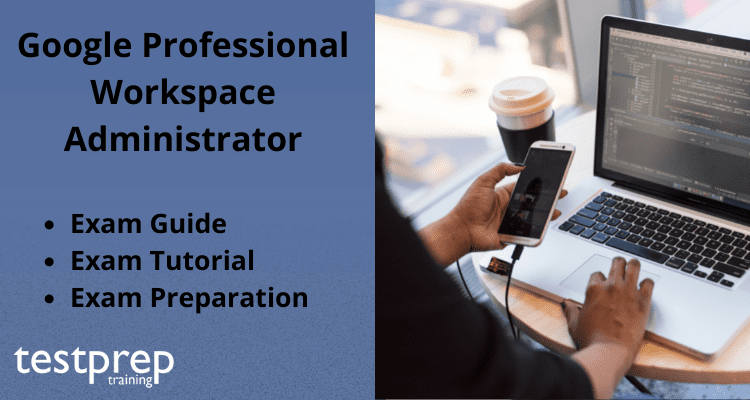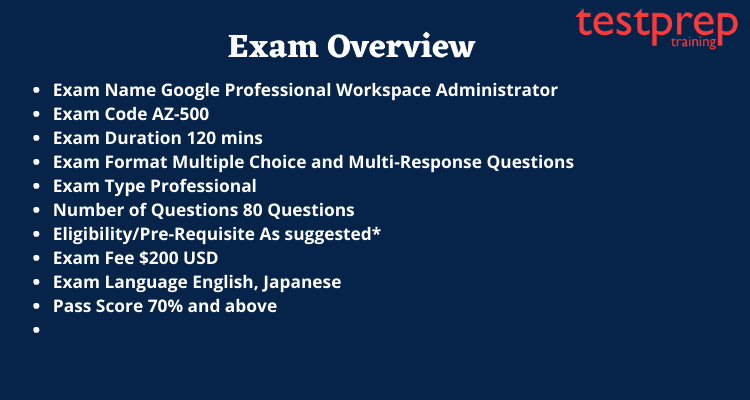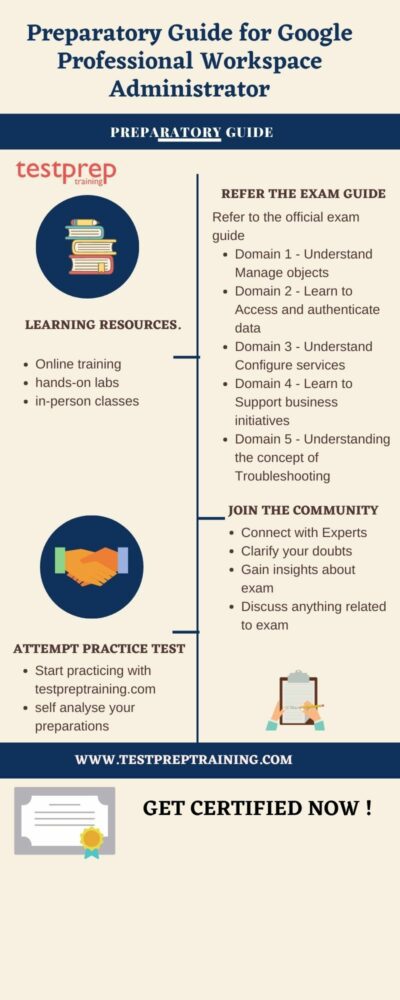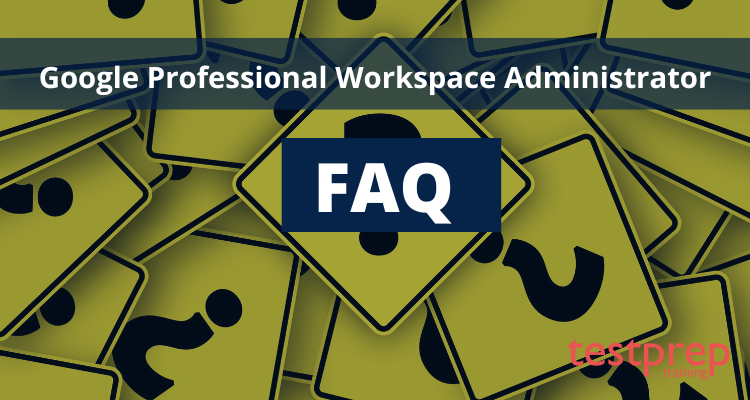Google Professional Workspace Administrator

The Google Professional Workspace Administrator exam has been created for professionals who are in charge of translating corporate goals into actionable configurations, rules, and security procedures pertaining to users, content, and integrations. For workers to collaborate, communicate, and access data in a safe and efficient way, Google Workspace Administrators must also have a full understanding of the architecture of the company.
Target Audience
- IT Systems Administrator
- Cloud Solutions Engineer
- Enterprise Google Workspace Administrator
- Systems Engineer
Recommended experience
3+ years of expertise in the field, including 1+ years of Google Workspace (formerly G Suite) management.
Exam Overview

Exam Registration
a) Attend the online exam from a distant location. Review the prerequisites for the online test.
b) Take the exam at a testing facility with on-site proctoring. Find a testing location close to you.
For more information, click on Google Professional Workspace Administrator FAQ.
Recertification Policy
To keep their certification status, candidates must recertify. All Google Cloud certificates are valid for two years from the date of certification, unless otherwise specified in the thorough test descriptions. By retaking the exam and receiving a passing score during the eligibility period for recertification, you can become certified again. Starting 60 days before the expiration of your certification, you may try to recertify.
Course Outline for Google Professional Workspace Administrator
Section 1: Managing objects
1.1 Managing account lifecycles by using provisioning and deprovisioning processes. Considerations include:
- Transferring ownership data to another account
- Provisioning users based on a process determined by an organization’s policy (for example, where to list accounts)
- Provisioning and deprovisioning accounts, including:
- Creating, reviewing, updating, deleting accounts (CRUD [create, read, update, and delete] operations).
- Adding users (for example, individual, bulk, and automated)
- Offboarding accounts (for example, suspending, deleting, and recovering)
- Editing user attributes (for example, renaming, passwords, and aliases)
- Creating administrative roles (for example, default roles, and custom roles)
- Revoking account access outside of a typical organizational policy (for example, security reasons and personnel issues)
- Configuring, monitoring, troubleshooting, and updating lifecycle management by using Google Cloud Directory Sync (GCDS)
- Auditing and reviewing GCDS (for example, interpreting log data)
1.2 Configuring Google Drive. Consideration include:
- Managing the lifecycle of shared drives based on user requests and organizational policies (for example, OU [organizational unit] placements)
- Configuring shared drive permissions, given specific requirements or scenarios
- Implementing shared drive membership permissions based on organizational policies
- Transferring user data from one user’s drive to another drive
- Applying security best practices for shared drives based on the business need
1.3 Managing calendar and calendar resources. Considerations include:
- Creating and managing calendar resources
- Managing and delegating calendar access and resources
- Managing the lifecycle of both individual and shared calendars (for example, differentiating between an individual’s calendar and a calendar resource)
- Configuring Google video conference room options (for example, Jamboard, Google Meet)
- Scheduling Google Meet conferences and livestream meetings or events
- Monitoring usage reports and recommending changes
- Troubleshooting calendar issues
1.4 Configuring and managing Groups for business. Considerations include:
● Configuring memberships and advanced settings, including:
○ Adding users to groups
○ Implementing current Google Workspace APIs
○ Automating tasks by using Apps Script
● Using a Google group to apply membership permissions for a shared drive
● Creating specific types of Google-native groups (for example, dynamic, security, identity-mapped, and POSIX)
● Implementing Google group security access controls to restrict members
● Troubleshooting issues in a Google group (for example, calendar invites not expanding, invites unable to be sent to a group)
Section 2: Configuring services
2.1 Implementing and managing Google Workspace configurations based on corporate policies. Considerations include:
● Assigning and configuring permissions to Google Workspace tools by using organizational units (OUs) and Google groups
● Modifying OU policies
● Implementing application and security settings according to OU inheritance and override settings in parent OUs
● Delegating granular Identify and Access Management (IAM) administrator roles and permissions to users in a domain
● Implementing security configuration options for installing or using Google Cloud Marketplace applications or add-ons
● Configuring Drive labels for data organization
● Configuring a Rapid Release or Scheduled Release for feature releases
● Configuring Google Meet to align with corporate policies and requirements
● Creating and configuring security and data region settings
● Implementing security integration protocols and addressing questions and objections from users
● Managing content compliance rules
● Investigating and remediating an issue by using Security Health Analytics check results
2.2 Configuring Gmail. Considerations include:
● Configuring basic mail routing scenarios for split delivery
● Configuring a mail host
● Configuring end-user access to Gmail by using Google Workspace Sync for Microsoft Outlook (GWSMO) or email client (for example, POP, IMAP, Thunderbird, Outlook)
● Configuring POP and IMAP access to align with corporate policies and requirements
● Configuring administrator access for mail forwarding by using advanced Gmail settings (for example, compliance rules, default routing, APIs)
● Managing and understanding all available spam controls (for example, allowlist, denylist, inbound gateway, and IP allowlist)
● Enabling email delegation for an OU
● Managing Gmail archives
Section 3: Troubleshooting
3.1 Troubleshooting mail delivery problems reported by users. Considerations include:
● Determining whether user behavior or a broader issue (for example, rules, or Cloud Data Loss Prevention [DLP]) is causing an error
● Determining whether an issue is an expected behavior (for example, a missing attachment, or an attachment filter issue)
● Auditing and reviewing mail flow structure and end-user actions to determine the root cause of delivery issues
● Analyzing message headers or email audit logs by using Google Workspace tools or security investigation tools
● Recommending and/or implementing an appropriate course of action related to mail delivery issues (for example, implementing mail policy changes)
3.2 Troubleshooting and collecting logs and reports needed to engage with the support team. Considerations include:
● Documenting steps taken by end user to reproduce an issue
● Collecting appropriate log file types
● Searching for known issues and application status
● Generating HAR files
3.3 Identifying, classifying, troubleshooting, and mitigating basic email attacks. Considerations Include:
● Configuring:
○ Blocked senders
○ Email allowlist
○ Objectionable content
○ Phishing settings
○ Spam settings
○ Gmail safety settings
○ Administrator quarantine
○ Attachment compliance
○ Secure transport compliance
● Implementing Sender Policy Framework (SPF); Domain-based Message Authentication, Reporting, and Conformance (DMARC); Mail Transfer Agent Strict Transport Security (MTA-STS); and DomainKeys Identified Mail (DKIM) to secure email transmission
● Investigating whether custom configurations are responsible for any issues or vulnerability (for example, email allowlist and IP addresses)
● Investigating the scope of email attacks by using available Google Workspace email tools
● Analyzing message contents for common attack patterns (for example, name, domain, and brand spoofing)
● Mitigating successful attacks and preventing future attacks by using Google Workspace email tools (for example, identifying the issue and responding)
3.4 Troubleshooting Google Workspace access and performance issues. Considerations include:
● Identifying why a user is having an issue when they access a single Google application (for example, Drive)
● Identifying the root cause of a performance issue when accessing a Google Workspace application (for example, a known issue, an outage, a network, or a device)
● Analyzing, evaluating, and modifying settings to ensure delivery of critical emails (for example, specific IP ranges, X-headers)
● Troubleshooting authentication issues that users reported
● Troubleshooting issues that users reported when they set up Google Workspace on a mobile device
● Troubleshooting Google Meet video call issues from the administrator console
● Troubleshooting Google Meet device issues by using the administrator console
● Troubleshooting network configuration issues to ensure high-quality meetings by using Google Meet
● Troubleshooting Jamboards
● Troubleshooting access to Google Workspace services (for example, Gmail and Drive)
● Troubleshooting data visibility issues by enabling/disabling licenses or services
● Investigating access issues in applications for OUs
● Interpreting and responding to alerts in the Alert Center API
Section 4: Data access and authentication
4.1 Configuring policies for all devices (for example, mobile device, desktop, Chrome OS, Google Meet Hardware, Jamboard, Google Voice, and browser). Considerations include:
● Configuring:
○ Chrome user and browser policy settings
○ ChromeOS device policy settings (for example, Enterprise)
○ Windows 10 login and device policies (for example, Google Credential Provider for Windows (GCPW)
○ Managed Chrome browsers (for example, Chrome Browser Cloud Management)
○ Basic device management
○ Basic and advanced device management for Android and iOS
○ Company-owned device management for Android and iOS
○ Context-aware access policies
○ Personal device settings for Android and iOS (for example, password, advanced, device approvals, application management, and insights)
● Enabling Endpoint Verification security by using BeyondCorp
4.2 Configuring and implementing Gmail DLP and sharing access control lists (ACLs) based on governance policies. Considerations include:
● Identifying areas of improvement for secure collaboration based on data exfiltration reports
● Scanning emails by using Gmail DLP
● Implementing Gmail DLP policies to prevent the over-sharing of sensitive data
● Configuring and implementing Gmail DLP options for data classification
● Configuring and implementing data classification settings on Drive
● Implementing context-aware access policies based on data governance policies
● Configuring settings to limit external sharing on Drive based on organizational policies
● Configuring settings to limit email delivery based on organizational policies
● Configuring and implementing client-side encryption services for Drive
4.3 Managing third-party applications. Considerations include:
● Implementing automatic releases of a browser extension to OUs within the domain
● Implementing security configuration options for installing or using Google Cloud Marketplace applications or add-ons
● Reviewing and authorizing user requests for a new Google Workspace Marketplace application, Google Play, or a Chrome extension
● Pushing an application to a user’s phone by using Google’s mobile device management (MDM)
● Configuring Google as a Security Assertion Markup Language (SAML) provider for a third-party application
● Deploying password-vaulted apps
● Deploying and restricting Google Workspace Marketplace and Google Play Store applications
● Granting API access to applications
● Integrating third-party user provisions
● Integrating third-party marketplace applications to specific OUs in Google Workspace
● Managing access to additional Google services (for example, AdSense and YouTube) for a specific set of users
● Revoking third-party author access
● Removing connected applications and sites
4.4 Configuring user authentication. Considerations include:
● Configuring:
○ 2-step Verification for the administrator and high-risk accounts (for example, requiring a physical key or not allowing SMS)
○ 2-step Verification for low-risk and standard accounts (for example, Google Authenticator)
○ Google-side connection to third-party single sign-on (SSO) providers
○ Google Multi-IdP options for SSO
○ Basic SAML SSO configuration for third-party application authentication when Google is the SSO provider
○ Third-party SSO for Google Workspace
○ Access control based on the use of the security functionality within API Controls
○ Google session control based on a company’s legal policies
● Implementing basic user security controls (for example, password length enforcement)
● Implementing security aspects of identity management, perimeter security, and data protection
Section 5: Supporting business initiatives
5.1 Using Vault to support legal initiatives. Considerations Include:
● Configuring retention rules based legal security policies (for example, setting retention rules, placing legal holds, exporting data for additional processing and review, auditing reports, and searching a domain’s data by user account, OU, date, or keyword)
● Assisting with or creating:
○ Legal matters to hold data
○ Export matter content (data) for analysis
○ Delegation protocols for Vault access
○ Google Workspace content by using Vault (searching)
○ Legal holds for Google Workspace content by using Vault
○ Vault audit reports (running)
5.2 Creating and interpreting reports for the business. Considerations include:
● Generating and interpreting user adoption reports (for example, Work Insights)
● Investigating issues by using the Alert Center
● Investigating and monitoring a service outage for a specific Google Workspace application
● Investigating issues by using data objects and metrics available within activity reports
● Configuring group alerts triggered by a specific event
● Creating and reviewing audit logs
● Using BigQuery to combine multiple Google Workspace logs and usage reports to provide actionable insights
5.3 Supporting data import and export. Considerations include:
● Assisting with off-boarding employees and transferring data (for example, Drive, Calendar, and Google Data Studio)
● Migrating Gmail data between Google Workspace accounts
● Exporting data from Google Workspace offline or to other platforms
Preparation Guide: Google Professional Workspace Administrator
It takes a lot of effort, focus, and knowledge of the many domains to pass the Google Professional Workspace Administrator Exam. With the help of this study guide, you will have access to all the necessary material and test details. This is a well-structured study manual to help you get ready for the test.

Review the Exam Objectives
The most important and initial step is to visit the official Google Adwords Advertising Fundamentals website before you start your preparation. The candidates should receive the necessary details and important exam instructions from this. Candidates can use this website to get all the accurate, up-to-date information they need about the exam.
The following crucial action is to thoroughly evaluate the course goals. The applicants should thoroughly research and learn each domain. This will help you comprehend the subject matter of each chapter and make appropriate plans. Candidates must work shrewdly in order to pass this exam, which necessitates a complete comprehension of the course content.
Join Study Groups
This phase is sometimes skipped or undervalued by candidates, yet it is typically one of the expert advice you will get from any previous successful candidate. A candidate must sign up for a specific group or online discussion forum that focuses on google AdWords. This is accessible online; all that is needed is exploration and participation in the most appropriate forum. It offers many advantages. To increase your knowledge and maintain attention, you can participate in group discussions, brainstorming sessions, and other interactive activities. This can help you boost your confidence and become used to the exam standards.
Practice Test Papers
Here is the essential tool for a candidate’s preparation process. This will give you more self-assurance and make it easier for you to become accustomed to the exam’s real questions. Furthermore, it will aid in your self-evaluation and produce superior outcomes. The applicants can concentrate on their areas of weakness while also being aware of their areas of strength. There is no such thing as taking an adequate number of practise exams. You get better the more you practise. Take a free practice exam right away to see for yourself, and don’t pass up this fantastic chance to develop yourself.


